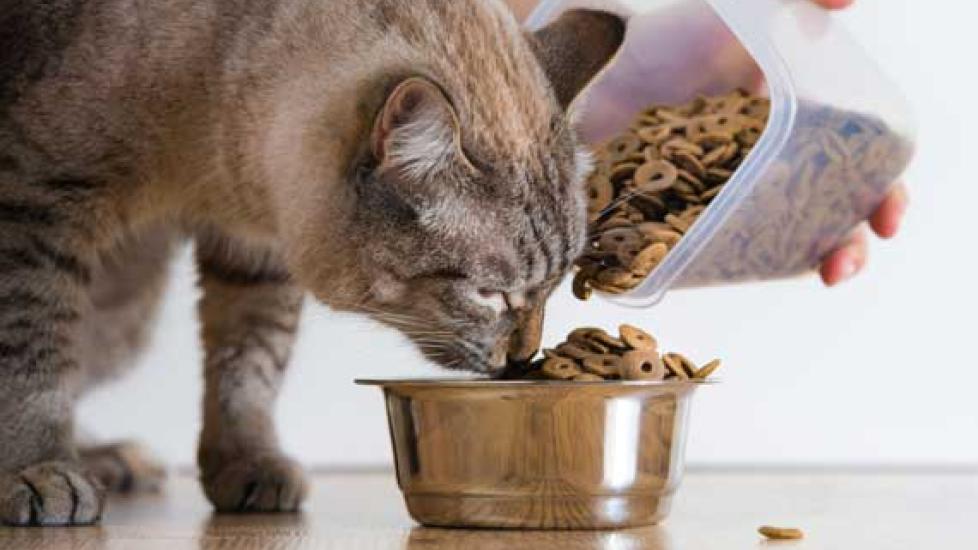5 Things That Could Help Prevent Cat Food Recalls Today
By Lorie Huston, DVM
The last thing you want to hear is that there is something wrong with your cat's food — that a recall has occurred. In fact, for many pet owners, the news of a pet food recall brings up bad memories of the giant melamine recall of 2007 that killed so many pets. While that type of recall is rare, there are pet food recalls that occur every year.
Let's discuss why many cat food recalls occur and what specific steps manufacturers can take to help prevent them from occurring in the first place.
Why Do Cat Food Recalls Happen?
There are many different reasons a pet food recall may occur. One of the more common reasons is that a contaminant has been found in the food. Contaminants may vary from a chemical contaminant that has somehow found its way into the manufacturing chain and into the food (as happened with the melamine recall) to bacterial contaminants such as Salmonella or E. coli.
Bacterial contaminants can be especially troublesome because bacteria like Salmonella and E. coli are everywhere. It requires thorough cooking of poultry, beef, and other meats to kill these bacteria and care must be taken to avoid contact between the cooked ingredients and the raw ingredients to avoid reintroduction. This type of bacterial contamination can be dangerous because these potentially pathogenic (disease-causing) bacteria can be introduced to a cat’s intestinal tract while eating the contaminated food and may cause disease. There is also a potential threat to pet owners who handle the contaminated food or the cat’s feces carelessly, without regard to good hygiene practices.
Other potential types of recalls occur when a particular food is not formulated correctly and contains an excess or deficiency of a specific nutrient. Nutrient excesses and deficiencies can be dangerous to a pet’s health, particularly when the food is consumed over a long period of time.
Another type of recall that is occasionally seen is a particular food that is mislabeled. In other words, the cat food that is contained in the can or the bag is not what the label states. While this typically isn’t terribly dangerous in most cases, the label is required by law to state correctly what the package contains.
How Can Cat Food Recalls be Stopped?
Though accidents do happen and we may never be able to completely eradicate pet food recalls, there are things that a pet food manufacturer can do to help prevent them from happening.
1. Keep Pet Food Operations 'In-house'
Manufacturing their own pet food rather than outsourcing the process to a third party is one of the most effective ways companies can prevent cat food recalls. By operating their own manufacturing facility, a pet food company has much greater control over the protocols practiced in the facility.
2. Source Ingredients Carefully
Sourcing ingredients from reputable locations that have high quality control standards is another step that pet food companies can take to reduce the occurrence of cat food recalls. Sourcing from questionable areas may lead to the attainment of poor quality ingredients, which may or may not be contaminated and/or otherwise adulterated.
3. Separate Cooked and Uncooked Ingredients
Because many potential contaminants are present in uncooked ingredients, it is important to separate these ingredients from those that have already been cooked, processed, and are ready for packaging. A pet food manufacturing plant should have physically separate areas for raw ingredients and cooked ingredients. Strict protocols should be in place to guard against transferring contaminants from one area to another. These protocols may include separate ventilation systems as well foot baths, protective clothing, and other hygienic procedures employees must practice when moving from the “raw” area to the “clean” area of the facility.
4. Set High Quality Control Standards
There should be an array of standard protocols and quality control tests that are performed routinely in the facility. Cleaning procedures must be strict and must take place regularly and without fail. Equipment should be maintained and inspected regularly to ensure that all is in proper working order. All employees should understand the importance of these protocols and know exactly what is required of them in terms of hygiene. Detecting and correcting weaknesses in protocols and failures in performance can help avoid a problem and a potential recall.
5. Initiate 'Hold and Release' Protocols
A “hold and release” program is a protocol that can be especially useful in preventing recalls. In these programs, the finished product is held from being shipped for sale until all testing has been completed and the results of the testing have been obtained and confirmed as being negative. In this way, potentially contaminated or otherwise faulty pet food never reaches the sales chain, never makes it into the hands of pet owners, and never needs to be recalled.
Choose Your Pet Food Carefully
Responsible pet food companies follow most, if not all, of these steps to keep the foods they manufacture safe for our pets. However, it may be difficult to impossible to discern what an individual company’s policies are based on what is printed on a cat food label. It's best to contact the company directly and ask them exactly what types of safety protocols they have in place. Ask questions and be suspicious of a company that cannot or will not provide you with the answers you seek.
